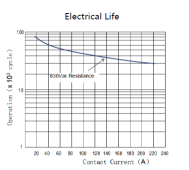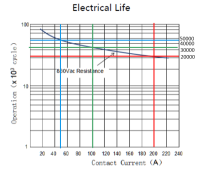FilterGuy
Solar Engineering Consultant - EG4 and Consumers
That was my first reaction as well. However, when I look closer at the data sheet, things seem more reasonable.Would I trust it to do this more than half a dozen times, absolutely not.
The spec sheet says


The 50A rating is at 830Vac. It is not specified, but at 240V it will be able to break higher currents and still meet the 30,000 electrical operations that are in the specification. However, since the sheet does not specify a 240V break current, we can't quantify an increase and we can only evaluate operation cycles at the 830V.
What is interesting is the Electrical Life chart. It gives operation count information for switching much higher currents.

At 50A the chart indicates almost 50,000 operations, but they only rate it for 30,000 operations for resistive loads. They gave themselves plenty of margin for variations from what they tested.
At 200A the unit has ~ 20000 operational cycles. However, the chance of it ever switching at 200A is pretty low. In most households, even the peak is closer to 100A or 30000+ operational cycles.

Even if we dived by 4 to cover inductive loads, it is 5k-7.5K operations. Since the switching event will normally only occur during a power outage, this seems reasonable.


